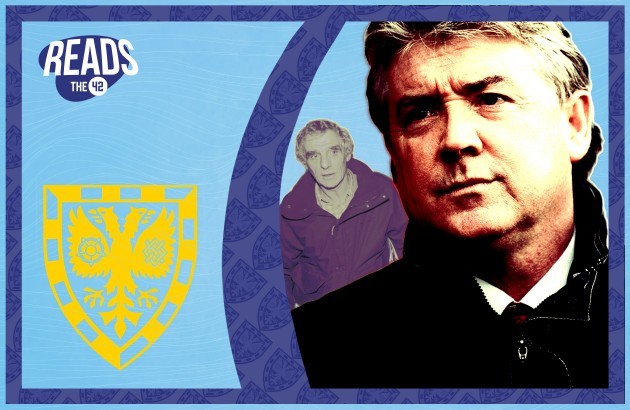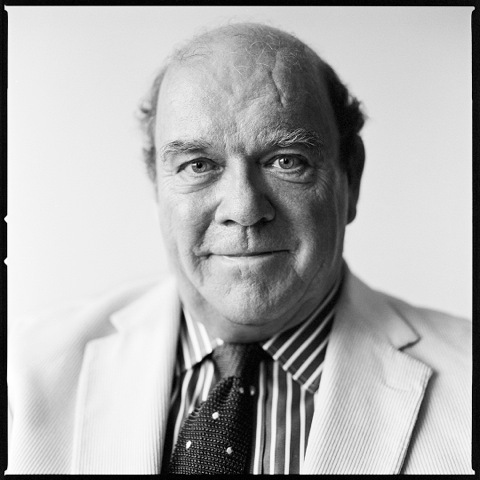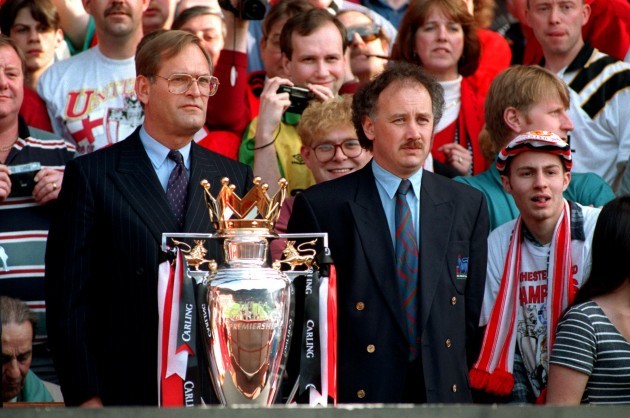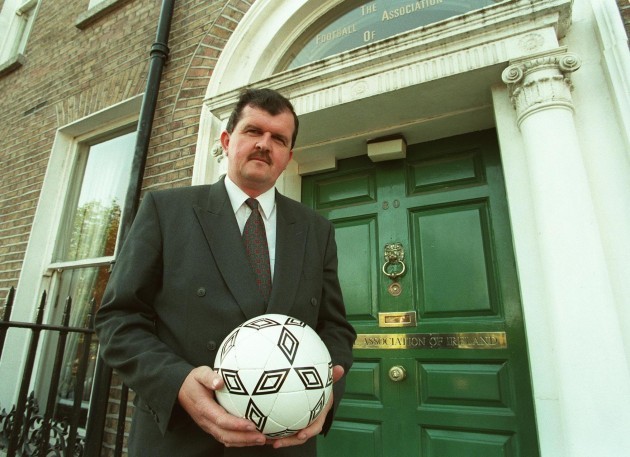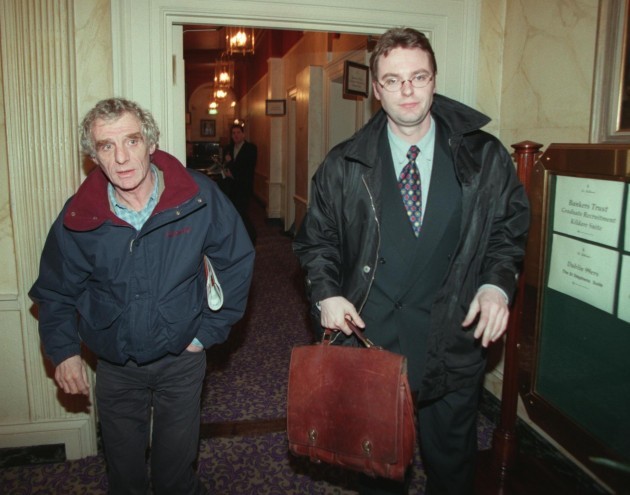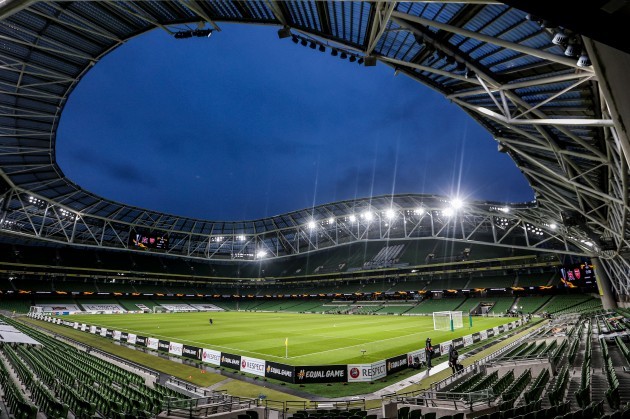In the mid 1990s, Eamon Dunphy helped to put together a consortium of Irish businessmen to launch an audacious plan: they would buy the struggling London club Wimbledon FC and move them to Dublin, from where they would continue to play in the Premier League.
The Dublin Dons earned huge media attention and a reaction that ranged from fervent support to righteous opposition, either side of degrees of amusement, bemusement and curiosity.
25 years on from its exploding in the public consciousness, some of the story’s key players recall the odyssey, explain why it didn’t happen, and wonder what might have been.
**********
Heartbroken Wimbledon FC owner Sam Hammam yesterday threatened to change the name of his club – and sever all links with the town. Hammam is on the brink of drastic action after being forced to abandon his plan to build a new ground in Merton.
Merton Council have refused planning permission for Wimbledon to build a supermarket on their old Plough Lane ground. Approval of the scheme was vital to the club’s plans to build a new 25,000- all-seater stadium on the nearby Wimbledon greyhound stadium site.
And Hammam yesterday declared that there was now no hope of the Dons, who have shared Crystal Palace’s Selhurst Park ground for the last three years, going back to their own borough.
“If it is feasible, we will consider changing our name”, he stormed.
- Irish Press, August 18 1994
Tommy Higgins (Consortium member, former head of Ticketmaster): I think I was the one who kicked it off. I got a note from [property developer] Owen O’Callaghan, who was proposing to build a stadium where Liffey Valley is now. I went to see him in Cork about it, and he was looking for information about what other events he could put on at the stadium. I thought it might have been an uphill struggle for him because he didn’t have what we call an anchor tenant.
A few months later, I was reading an article in the Sunday Times about Sam Hammam having some row with Merton Council about the old Plough Lane Stadium. He was having a difficulty there, and he was talking about moving the club as he said he couldn’t survive on crowds of 8,000 or 9,000 people at Selhurst Park.
I thought, ‘Here’s Mr O’Callaghan with a stadium but no team, and Mr Hammam with a team but no stadium’, so I wrote Sam a letter, not thinking it would go anywhere. But I got a phone call back only three or four days later.
I asked if he wanted me to go to London and have the conversation. So a friend and business partner of mine, Maurice Cassidy, and I went over to see him. That was in September ‘94.
We met him at the Dorchester, and he said, ‘It’s a great idea, but it’s crazy. Crazy, crazy.’
Later, I got a note back from him saying, ‘Thanks, it is a great idea, but no.’
That was that until the following year, Maurice and I were going up Baggott Street one day and met Eamon having a coffee with Paul McGuinness, and the conversation got around to the Wimbledon thing.
- For more great storytelling and analysis from our award-winning journalists, join the club at The42 Membership today. Click here to find out more >
Paul McGuinness (Consortium member, former manager of U2): In the early days of U2, I got to know Dunphy as part of a group of late-night stragglers that included Shane Ross, Paul Tansey, and PJ Mara. We used to meet up for pints, and there was a dreadful nightclub called Joy’s.
Dunphy had been an Irish international player at the same time as Joe Kinnear, and they were buddies. Joe was the manager of Wimbledon, and Dunphy and Joe had this idea of buying Wimbledon, who were owned at the time by this guy called Sam Hammam.
Eamon Dunphy: Joe and I used to room together when we were away with the Irish team, we were good friends. He rang me up and said they couldn’t make Plough Lane pay. They were getting crowds of between 5,000 and 10,000 in the Premier League, which wasn’t viable.
Tommy Higgins: The boys were talking and thinking it was a great idea, so we joined forces and put together a little consortium. After that meeting on Baggott Street, we revitalised the idea.
Eamon Dunphy: I was just someone in our group who could join the dots. I reached an agreement with the guys: they wanted to give me a share, I said ‘not now’ – I was a journalist and needed to retain my independence – ‘but if we get it over the line then we will see how we go.’
Paul McGuinness: Somehow, this ad hoc group of mates that included me, and also Tommy Higgins and Maurice Cassidy became kind of conspirators. The meetings used to take place in my office – in the management office of U2 – and they were always very enjoyable.
The plan was strengthened by the addition of Owen O’Callaghan, the property developer, who had planning permission to build a stadium in West Dublin.
The plan was to buy Wimbledon from Sam Hammam, move them to West Dublin and have them continue to play in the English Premier League. It was an attractive proposition: every two weeks there would be a Premier League fixture in Dublin.
We made informal approaches to the IRFU, the idea was until the new stadium was built in Neilstown, in the interim this team that were already being called The Dublin Dons, would play at Lansdowne Road in the short-term.
Eamon Dunphy: I spent a lot of time doing this as I thought it was a fantastic opportunity for Dublin, provided we could achieve certain things. One of them was the stadium, of course.
There was a lot of hostility toward the idea from some journalists here – eejits, most of them – and they didn’t realise what it would mean for Irish footballers: they wouldn’t have to leave their home to become Premier League players.
Tommy Higgins: I thought it was a great project, and I still think had it happened, it would have been huge. In the context if you look at what has happened to the FAI today and the mess they are in, they were getting a free stadium.
We wrote to Sam, and invited him to Dublin. It was the funniest meeting I was ever at. Sam arrived over with his brother, pumping his chest, and again saying, ‘Crazy idea, but the supporters would lynch me’ and all that stuff.
But he got enthusiastic about it, and more or less said it would be a great idea. He wanted us to buy the club and play in England first and then move it over. We weren’t interested in that, we wanted to buy it and move it over.
The stadium wouldn’t have been ready, but O’Callaghan, once he got an anchor tenant, would have got the funding.
We showed Sam the plans for the stadium: a 40,000-seat stadium, with the provision to bring it to 52,000 if it went well. It was very well thought-out, there was a bridge coming across the M50 and a train service – O’Callaghan had all his homework done. It’s where the Liffey Valley shopping centre is today.
Sam said, ‘The first thing you need to do is build a church for the fans.’
‘Okay Sam’, O’Callaghan says, ‘We’ll build a church.’
We agreed a price. It was for £6 million, for 74% of the club.
We shook hands, and at one stage the boys went down to the corner of the room and started talking in Arabic. We were over in the other corner thinking we should maybe start talking in Irish, but we didn’t have a word of it.
Then we said we would do some due diligence, there didn’t seem to be any problems.
Paul McGuinness: We had a deal for what didn’t seem very much money to buy the team. We would obviously have needed further financial support but in back of the envelope terms, we believed it was a viable business.
It was always pretty clear to us that if this was going to happen in Ireland, it would have to have the support of the FAI, and there would have to be some financial benefit to the FAI.
We thought, naively perhaps, that they would see this, and see that talented young Irish players would have a Premier League team on their doorstep.
Tommy Higgins: We picked up that Sky Sports would have been all for it, and to make it work we would need the blessing of the FAI, Uefa, and Fifa. Sam claimed he would be able to get the Premier League chairmen to vote for it.
Rick Parry (Then CEO of the Premier League): There were obviously going to be obstacles, there always are with anything cross-border or with anything that’s vaguely radical. But there was quite a bit of interest within the Premier League: certainly it wasn’t just ruled out.
It was different from, for example, the question whether we would admit Celtic and Rangers, which frankly never found any favour with the clubs as that would mean getting rid of two. This was different, it was giving Wimbledon the opportunity to become more competitive and expand its fan-base, and do something innovative.
People had some daft ideas, this wasn’t in the realms of being ridiculous. You could see it would improve the reach of the Premier League.
There was probably scepticism among some clubs thinking, ‘Blimey, it will never happen’, but the mood was, ‘Okay, let them come back with a formal proposal and we’ll ultimately vote on it.’
**********
Dublin may be regarded as the fun capital of Europe but don’t mention that to the furious fans of Wimbledon. The London Dons staged an angry demonstration at Selhurst Park on Saturday against their club’s proposed move to Ireland. Some 3000 people, nearly one third of the club’s regular support, flatly refused to leave the ground after their team’s 5-2 mauling against Manchester United.
Placards and leaflets proclaiming “Dublin equals death” were waved by the protestors, and for nearly two hours they roared defiantly, “We’re never going to Dublin” and vented their anger on Wimbledon Governor Sam Hammam and team manager Joe Kinnear.
- The Daily Telegraph, 17 August 1996
The move to bring Wimbledon FC to Dublin has been shown the red card by football fans. Hours before the kickoff of the new League of Ireland season, a new team was launched in Wynns Hotel. It’s called National League United and it’s made up of supporters of the country’s top soccer clubs. Fans of Bohs, Shels, The Hoops and Pats chanted with one voice, ‘Resist the Dublin Dons.’
‘If Wimbledon move here, the game will be dead within five years’, said Hoops superfan John Byrne.
- Evening Herald, 31 August 1996
Paul McGuinness: We caused a certain amount of consternation among the powers that be in Irish football.
Bertie Ahern (then Taoiseach): My recollection of it was that my good old friend Eamon was supportive of it, but the League of Ireland guys were very much against it. They felt bringing in the Premiership would suck the interest, crowds, media attention and advertisement to Premiership matches and it would be detrimental to them. I clearly recall there were no takers from the League, and there weren’t many takers at the FAI either.
Bernard O’Byrne (then CEO of the FAI): When I went in [to the role of FAI CEO] it was the first file on my desk. Initially, I thought it was just yet another kind of madcap proposal but this quickly became serious as more serious people were involved, because it was the Premier League and because the other side was driving the media campaign. So I quickly realised I was going to have to deal with this.
Tommy Higgins: We were also proposing we would have a fund with matching government money which would revitalise soccer in Ireland. The rising tide would carry more than one boat.
Eamon Dunphy: The FAI were arguing it would hurt Irish football, if you can believe that, and that the League of Ireland would suffer. They were wrong on both counts: I’ll give the example of Brown Thomas. If you took Brown Thomas from Grafton Street, it would kill Grafton Street.
The Premier League would have popularised Irish soccer, there would have been a spill off in players and cash for the League of Ireland. It would have transformed the game here.
It never got past O’Byrne, who was a servant to what I would call the backwoodsmen of the League of Ireland. He was the gatekeeper, he wasn’t playing and he wasn’t going to play. He didn’t see the good it would do, he kept saying it would destroy League of Ireland clubs and all that. That was the theory but it’s a misguided theory. I don’t believe that’s true.
Tommy Higgins: Bernard had to bat his own corner and I totally understand that.
Bernard O’Byrne: On a personal basis, I wouldn’t go so far as to say I was in favour of it, but I was in favour of finding out more about it. If there was a proposal that could make a win-win situation for League of Ireland or schoolboy football, ‘Why not look at it’ would have been my stance on it. But in a professional situation at the FAI, I was given my instructions, which basically were, ‘We’re not having this, end of story.’
At that time – I’m not sure what the situation is now – the League of Ireland really held a strong hand on the FAI. The top man at the time would have been Dr. Tony O’Neill who was an out-and-out League of Ireland man. And so the League of Ireland said, ‘We’re not having this.’ Behind closed doors some of them weren’t as trenchant, but publicly, they certainly were.
Sam was over in Dublin several times, at dinners or lunches with League of Ireland people, and there were a handful of clubs who were using backdoors to speak to Wimbledon in the middle of the whole thing, but certainly the majority of the League of Ireland were against it.
Rick Parry: I do remember one prominent member of the FAI, who I had better not name, literally saying to me, ‘Of course, we are against this, but you understand that we are for it.’ Which I took to mean, ‘Publicly we have to be against it, but let’s explore it.’
Bernard O’Byrne: I would have a good suspicion who that was and it doesn’t surprise me that they would say it. There were individuals within the top rank who were open to it. But the FAI just wasn’t moving on it. There was a board of 10 people there, and while two or three people might have swayed, there was no way the whole board was going to move.
In a way, it didn’t really matter what the Premier League said. What mattered was what Uefa and Fifa were saying. At the time, [FAI Board member] Des Casey was a Vice-President of Uefa and we had that one nailed down.
Eamon Dunphy often threw at us that we didn’t have the money to battle this case in court, and he was dead right. We didn’t have the money. But Uefa and Fifa had the money, so it didn’t matter.
Eamon Dunphy: The position as far as Fifa was concerned was the following: the Bosman ruling changed everything in football. His club were restraining his right to move and get a better salary, and he took the case on the basis that professional soccer was a business; that it wasn’t a sport as such, but obeyed the laws of business. In the European Court, when push came to shove, the European court found in favour of Bosman.
I knew about this, I marked the guys’ cards that even if Fifa tried to stop it, they would lose in court. At that time Pádraig Flynn was the European Commissioner for Social Affairs. He was a friend of Owen O’Callaghan’s, and said to bring Sam to Brussels, which Owen did.
Sam was a very self-important, bumptious little fucker, but Pádraig Flynn put manners on him, basically. He said, ‘Don’t fuck with these lads, they are friends of mine.’ He assured us we wouldn’t have any issues with Uefa or Fifa as the Commission understood the Bosman ruling and its consequences.
Paul McGuinness: Sam was a character.
Tommy Higgins: Sam invited us over for the opening game of the ‘96 season, and that’s when it kind of exploded. A lot of people spotted us there, it was the opening game of the season against Manchester United, the day David Beckham scored the famous goal from the halfway line.
The night before we had dinner in Sam’s house, and all was fine. It got huge press, all the big Kahunas in the British press at the time supported the move.
We did our due diligence, and everything was as Sam had said it was. We sent the draft contract across, and then Sam disappeared again.
He wouldn’t take phone calls. Zilch.
Rick Parry: I was never sure as to why it didn’t happen. It must have been because Wimbledon couldn’t get it over the line.
Eamon Dunphy: To cut a long story short, Sam ended up using us as bait.
Tommy Higgins: I was going through Gatwick one day, maybe a year later, and I looked up at a screen and next thing I see that Sam had sold Wimbledon for £28 million to a Norwegian consortium.
Paul McGuinness: We got a big shock one day when it was announced Sam had sold the team to a couple of Norwegian shipping businessmen.
Tommy Higgins: ‘Ah Jesus’, I thought with my mouth open. But good on you, Sam, if you were able to flush out £28 million.
Eamon Dunphy: That’s what happened. The Norwegians then got cleaned out and dropped it like a hot potato as it wasn’t a viable business in South East London. It was a lose-lose for everyone but Sam.
Bernard O’Byrne: If that was the case it was a charade from start to finish.
Tommy Higgins: To be honest, it was always a long shot. We were in the entertainment business – Maurice Cassidy was the Riverdance promoter – and the entertainment business is crazy. So this would not have been unusual behaviour from our point of view. We had figured out by the time he had stopped answering and replying that it was gone.
Paul McGuinness: It just kind of petered out.
Rick Parry: I always thought he was genuine about it. But it was kind of interesting he turned up at Cardiff City [Hammam bought control of Cardiff City in 2000, after he sold his remaining stake in Wimbledon] as it’s similar, isn’t it? I don’t know, but I always thought when he turned up at Cardiff, ‘Blimey, he didn’t manage it with Dublin so he’s trying it in a less controversial way.
**********
AFC Wimbledon have been elected to the Combined Counties League. The new club, formed and financed by disgruntled supporters of the Nationwide League side Wimbledon, will play its first competitive game on 17 August. AFC Wimbledon was set up by a group of Dons supporters angry at Wimbledon’s possible relocation to Milton Keynes.
- BBC Sport, 25 June 2002
The latest chapter in one of the most controversial sagas in recent footballing history has been written, as the Football League has given Wimbledon permission to change their name to Milton Keynes Dons FC. They currently play at the National Hockey Stadium, but hope to eventually move to a new 28,000-seater ground in Denbigh. The InterMK consortium headed by music promoter Pete Winkleman is poised to complete a takeover and take the club out of administration.
The Guardian, 21 June 2004
Bernard O’Byrne: I think the consortium should have written to the FAI before they went to the media or anything like that. I think that stood a much better chance of success. There had been secret meetings with various clubs and various individuals, so the first thing that arises in people’s minds is, ‘What is going on here? If they want it to be secret it must be detrimental to us. If it wasn’t detrimental surely they would have come through the front door.’ That was the absolute mistake they made. If they were serious about it, that is the first thing they should have done.
Tommy Higgins: I don’t disagree with him, but there was never a right time to press the button, we had to get all the ducks in a row.
Paul McGuinness: What we really had to do was to produce a situation or proposal they would be able to support. We knew it would be madness to do without the support of the FAI, but we needed to design the scheme before that could be achieved.
Eamon Dunphy: We didn’t go through the back door. We saw Mary Harney, we met Bertie; there was no back-door stuff about doing it behind the FAI’s back. All the media knew, it wasn’t a secret coup or anything like that.
God knows, the potential of it was immense and it would have been a transformative moment in Irish life and Irish culture, never mind Irish sport.
Bernard O’Byrne: If they had built a stadium and it had taken off, I think there would have been a period of positivity. But you have to ask, how long would that scenario have been needed to bankroll the League of Ireland, and would the League of Ireland have gone from strength to strength, or would it have imploded, as a lot of people were saying?
Anybody who wanted to put money into football at that time would have wanted to put it into the Dublin Dons. There was a theory that money would drain out of Irish soccer toward this major project that was going on. And what happens if the Dublin Dons get relegated and it’s Scunthorpe coming over instead of Manchester United? There was no guarantee it would be Premier League football for ever and ever.
And this amazed me at the time: the sign-off the Gardaí gave to five or six thousand English supporters coming into Temple Bar every second weekend. Was there any chance that would have become unmanageable, or out of hand? There were a lot of imponderables.
It could have been the land of milk and honey. But I’m not sure things always work out that way.
Rick Parry: There were all sorts of implications. What happens if they get relegated and people lose interest? But if the concept is good you can build in safeguards to work against it.
You’d have had the stadium, and you would also have had a first-class academy.
Would it have befitted the Irish national team? Arguably yes. Because of the academy, and they would be finding their own route into Premier League football and maybe playing together rather than disappearing all over the place.
To become the best you have to play with the best, the Premier League is the best, and if you’re keeping them at home and playing in the Premier League, what’s the downside?
Eamon Dunphy: It was a similar idea as John [Giles] and I had for Shamrock Rovers. All I wanted was for Irish football to prosper, and the only way for it to prosper was having a major club in Dublin. It wasn’t the same model as the Shamrock Rovers model, but it was even stronger in terms of the money element, the stadium element, and the timing of it.
There was no Premier League when we started at Rovers in 1977. The Premier League became a really big thing in the late ’90s, and it has grown into a very serious and lucrative thing.
I wanted a chance for young Irish footballers not to have to go away and cut all ties with home to get their chance. I knew if we had top class coaches at a Premier League club, they would learn their trade and even if they didn’t play for Wimbledon, they could play for League of Ireland clubs.
It’s heartbreaking, the number of young Irish lads who go away and come back having lost three or four years of their lives. They have lost their education, they have lost contact with their friends and family, and don’t have skills to start a job. It is cruel and it didn’t need to happen and it had happened to me.
That was the side of it that most excited me, along with the prospect of hosting Premier League football every second week. My motives were purely for football.
Paul McGuinness: It was an interesting group and an interesting project. I hadn’t been involved in football, but I was interested in any part of show business, and football is part of show business. Anything that attracts large crowds who pay for tickets appealed to me. It was a very good business and a growing business internationally, and the years since have borne that out: football is bigger than ever.
Tommy Higgins: I think it would have worked, it would have raised the profile of Irish soccer. The FAI wouldn’t now be in such debt as they’d have got a free stadium, and there was also a plan. I’m now chairman of Sligo Rovers, and I always felt Irish soccer was neglected. Which it was.
If you go back to the 1960s, there were huge crowds going to soccer in Ireland, but they never built on it. They should have built up their infrastructure and their stadia like every other country in Europe had done.
What also happened, once Jack arrived the magic was unbelievable, but it all went to the international team. There was no one there with the vision to see you needed the domestic game at a very high level. We believed having an Irish club here with an Irish identity would have been huge for grassroots soccer.
The FAI felt it was a threat, but I never felt it was a threat. I saw it as a very positive thing. I have no doubt that Sky would have invested more money in Irish soccer. The FAI were afraid of something new. I am not saying they were wrong, they had to bat their own corner, but I think they didn’t have the vision at the time.
The debt of the FAI now speaks for itself. All that money that has been ploughed into a stadium they ultimately won’t own. Look at soccer around the world: Germany don’t own their soccer stadium, the Spanish don’t own their soccer stadium, the Italians don’t own their soccer stadium. England can’t wait to get rid of Wembley, it’s costing them too much and it’s up for sale. Running big stadiums like that is for municipalities and governments.
Bernard O’Byrne: It never got that far, but I am sure the FAI would have built [a rental deal for international games] into the agreement, as we were looking for a home to get us out of the rental agreement at [the old] Lansdowne Road. I haven’t given it a lot of thought, but it would have taken the rental off our back, which was always a major financial burden. We still wouldn’t have been owners but you enver know what deal we could have hammered out with them. It may have been a much better deal than we had back then with Lansdowne Road and a far better deal than we have now.
Tommy Higgins: They [the FAI] would have rented the stadium from O’Callaghan, and it would have made a lot of sense, and there would be no big debt. A small operation like ourselves, owning, trying to finance and taking on that enormous debt for a stadium was absolutely crazy. It never made sense, it was in debt from day one, and the chickens are coming home to roost now.
Eamon Dunphy: It would have been a dream come true, really, for Irish football and Irish sport.
Tommy Higgins: I look back at it as a fabulous adventure. I don’t regret the time spent at it. Eamon was consumed by it – we all were – but you win some, and you lose some.
And we lost this one.
For more great storytelling and analysis from our award-winning journalists, join the club at The42 Membership today. Click here to find out more >

